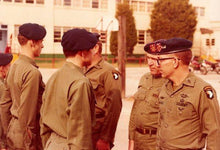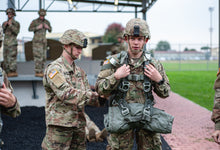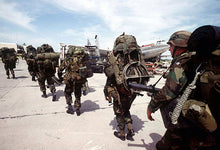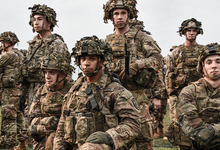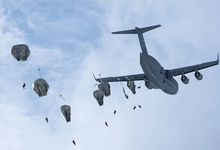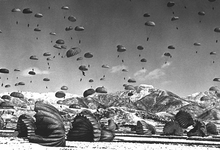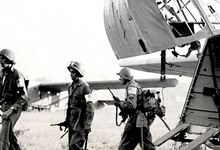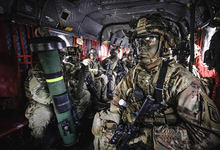The recent buzz has it that the British Army is soon to be training with humanoid robotic targets that can come alive in virtual reality. While what seemed to be a far-fetched idea a couple of years ago with respect to the incorporation of virtual reality in military training by simulations, the recent announcement sets out the use of humanoid robotic targets for training British Army paratroopers.
It has been announced how the Troops at 16 Air Assault Brigade will make use of simulations, augmented reality, and virtual reality facilities to give them a unique, high-end, and technologically advanced training experience compared to the rest. The VR facilities are to be set in Colchester, Essex and have garnered a range of constructive and approving responses with respect to noteworthy diminutions in military training budgets.
The paratroopers at 16 Air Assault Brigade will make use of robots, which appear identical to mannequins in reality. However, the power of the VR will feign and mimic them as avatars of opponent fighters, causing an uproar in foreign languages and shooting pellets and capsules.
How does it work?
These humanoid robotic targets are better known as ‘SimStrikers’, which are commended for the incorporation of a layer of tactical performance analysis to the existing 4GD facilities of intelligent training adversaries. These can be networked and synchronized in a synthetic atmosphere so that the target looks similar to a digital avatar of a real-life antagonist. The three-dimensional environment tends to replicate and perfectly depict all real-life actions. As the automation activates and falls, the avatar within the VR also falls in a similar manner.
4GD, the British defense organization, supplies about ten of the ‘SimStrikers’, for the British Army’s 16 Air Assault Brigade.
Rob Taylor, the founder of 4GD talks about how the company is thrilled to officially announce the launch of SimStriker and looks forward to providing continual support to the British Army with technologically progressive solutions for data-driven insights and impactful close combat training.
The humanoids are set up and embedded within a VR environment which provides an enhanced learning opportunity to the troops with respect to real war zones, where they might be expected to fight in a real war.
Taylor further discusses how an amalgamation and encounter of the real and virtual world was direly required. The urban training and room clearance are physical; however, entering the building and clearing an array of flats allows the paratroopers to explore the virtual landscape through the windows.
4GD’s SimStriker
It goes without doubt that VR in the military has become more than a mere concept of movies and books, and delivers a seamlessly realistic experience of placing soldiers within a life-threatening ‘virtual environment’. 4GD’s SimStriker shuns the conventional practices of wooden targets within the battlefield simulation and offers a distinctive variety of smart adversaries that contribute favorably to the overall realism of the simulation. SimStriker is also recognized for its functions of evaluating the efficiency and usefulness of its troops with measured and calculated accuracies, thus leading to the augmentation of their urban combat know-how and experiences.
Furthermore, the all-new edition of the humanoid mannequins is also known to rotate to pose significant threats to their opponents as they enter buildings, indulge in fire scenarios, or shoot down. The power of virtual reality is witnessed as the challenger is attacked through a bullet and collapses to the ground.
The newly designed and launched mannequin can also take into account the movements of light and sound, and integrate the voice feature to respond to the target. The domain of virtual reality promotes the lives of these mannequins as personifications and embodiments of adversaries. SimStrikers have been enabled and designed to shoot and shout in foreign languages such as Arabic and Russian. Another striking attribute of humanoid mannequins is their ability to record trainee firing rate and accuracy of hitting targets.
The training complex is further enhanced through the presence of a virtual battle zone that impressions real cityscapes. This can be used by the trainees to shoot javelins.
About 4GD
In today’s fast-paced era of submerged intimate combat training, 4GD is at the forefront of accomplishing operational fineness and superiority using realistic, immersive, and dynamic amenities in its roots. It specializes profoundly in delivering the most top-notch and cutting-edge technological evolutions to the defense market, with the aim of mitigating the existing gaps between training and operational reality. Technology serves as a key driver of operational performance as it boosts the levels of realism, delivers scalable intricateness within scenarios, and provides a range of targeted improvements. As the VR feature continues to gain prominence in the global market, 4GD is already on the road to creating intuitive systems for its user.
4GD has been announced to lead the launch of the SimStriker urban warfare training program for the British Army in Colchester for its 16 Air Assault Brigade. The division is expected to obtain ten smart targets, thus signaling the first delivery of 4GD’s revolutionary creation.
It is expected to witness multiple instances of British Army training using the SimStrikers during 2022, as stated by 4GD Operational Director Matthew Harrison since the organization strategically contends and tackles the hurdles of microchip supply shortages.







